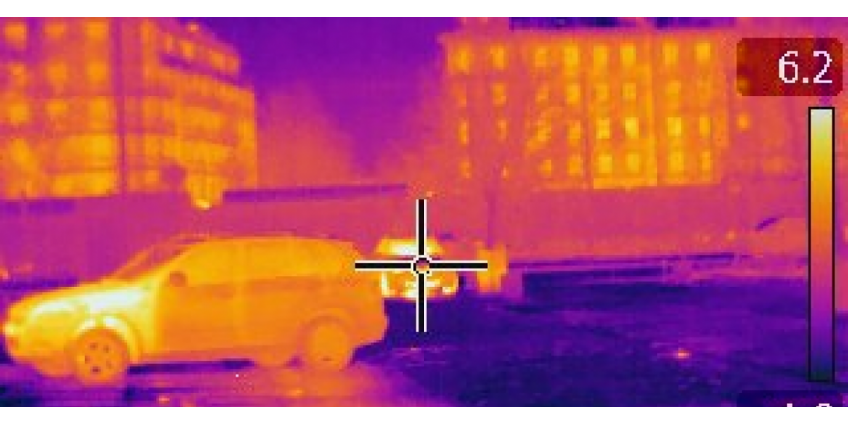
This product is not exportable outside the United States.
By adding this item to cart, you agree and acknowledge the Export Policy and confirm that you are a person in the United States with no intentions to illegally export the device.
This product is not exportable outside the United States.
By adding this item to cart, you agree and acknowledge the Export Policy and confirm that you are a person in the United States with no intentions to illegally export the device.


0

0


Before
choosing an infrared camera, there are several factors users must understand,
specifically the different types of IR detectors, cameras and specifications
and how these can affect system performance. There are allot of factors to
consider as far as temperature variance, shutter speed, and ultimately cost and
value of the thermal imaging camera.
It
is relatively easy to understand the relative temperature variances in a
color-mapped thermal image device, as depending upon the color palette settings
warmer colors tend to be hotter temperatures (red, orange, yellow) whereas the
cooler colors tend to be colder temperatures (green, blue, purple). This system
provides a consolidated view of cold to hot in an easy to read visual interface.
If accurate temperature measurements are required though, several potential
error sources must be considered: emissivity of the surface, the viewing angle
of the camera, surface reflections, and the transmission characteristics of the
target, atmospheric conditions, spatial resolution limitations and motion blur.
If one or more of these considerations are overlooked, temperature accuracy
will suffer significantly.
Reflections
are another source of error. Hot objects in the vicinity of the target being
measured may reflect from the target. Since the total temperature includes
reflected energy, any reflections can mask emitted energy and degrade
measurement accuracy.
Depending
on their physical characteristics, some targets may have transmission issues.
Thermal cameras can see through some types of materials, particularly some
plastics. Thus, it is important to ensure that a lot of energy is not being
transmitted through the object being observed, otherwise the temperature behind
the target may be detected rather than the surface temperature.
Good
quality IR cameras have a temperature accuracy of about +/-2o Celsius, or 2% of
full scale, whichever is larger. Unfortunately, it does not matter whether the
camera costs $5,000 or $100,000, the accuracy is not much better than +/-2 °C.
If more accurate measurements are required, the use of thermocouples may be a
better option.
There
is a reason why there is a large price difference between calibrated
thermography cameras and un-calibrated cameras. High end, factory-calibrated IR
cameras require that precise temperature calibration is performed in a
laboratory. Such cameras also need to compensate for the temperature drift of
the detector, which requires temperature sensor and compensation electronics
inside the camera. These features are typically not included in lower-cost,
non-calibrated cameras.
On
most IR cameras, there is an iris-type shutter that is used to compensate for
temperature drift. Periodically, clicking noises may be heard from a thermal
camera indicating that the shutter has been shut in front of the detector, and
the camera is recalibrating to compensate for thermal drift. This automatic
calibration typically takes a few seconds, executing during startup or if the camera
detects an internal temperature drift. This temperature recalibration needs to be taken into consideration for
automated imaging applications because the camera is "blind" during
recalibration and the continuous image data stream will be interrupted. This is
commonly referred to as NUC and can be manually done on several devices to
ensure the correct calibration of the device.
Noise-equivalent
temperature difference (NETD) defines the detector's ability to distinguish
between very small differences in thermal radiation in the image. A typical NETD
of an uncooled microbolometer is somewhere below 50milli-Kelvin (mK). Cooled
cameras that are photon-based, or have photon-based detectors provide better
than 20mK. Thus, if a high-degree of measurement sensitivity is required, a
cooled camera may be needed.
In
cameras with multiple measurement ranges, the NETD depends on the selected
measurement range. The smaller the temperature range, the better the NETD.
Matching the NETD of the camera to the application is important and this is
particularly true if lower temperatures need to be measured or the application
requires greater temperature precision.
When
choosing a camera, it is important to know the field of view, accounting for
moving targets, as well as seeing through obstructive enclosures.
If
moving targets need to be imaged, it is important to understand how fast the
target moves through the field of view of the camera or, more specifically, the
distance (in pixels) that the target moves during the integration time. This
can occur for motion blur in tracking moving targets. It is recommended to use
a higher pixel resolution sensor and core to provide a clearer image so there
is no thermal smearing.
Lenses for thermal image cameras are made from
exotic and expensive materials, such as Germanium, Zinc Selenide, or Sapphire
that transmit specific IR wavebands and are matched to the detector of the
camera. IR lenses are also curved aperture lenses, increasing the cost of
manufacturing these high quality and high end optical lenses.
Protective
enclosures are also necessary when installing cameras in hostile environments.
Since IR cameras cannot look through standard glass windows, camera enclosures
require exotic windows of Germanium, Zinc Selenide or Sapphire. The window material
must be matched to the specific camera and the environment to allow heat
transmission through the protective enclosure.
Table of contents
Featured Articles
How does night vision technology works? Infrared illumination. Infrared light. Myth and reality. Infrared flashlight, IR floodlight and solar powered ..
A lot of people don't know the principles of passive infrared technology. In this article, we'll reveal it, tell how to become invisible and hide from..
Focusing on variances in technology within security cameras, this addresses how security cameras work utilizing night vision technology..